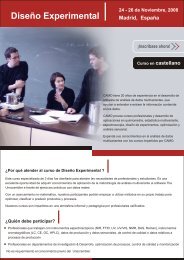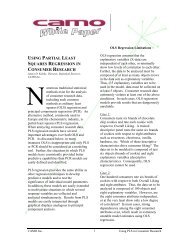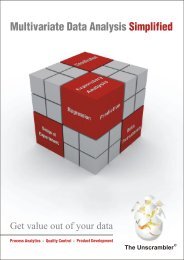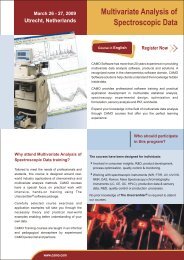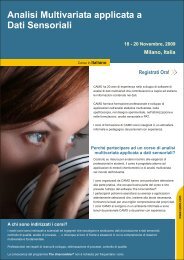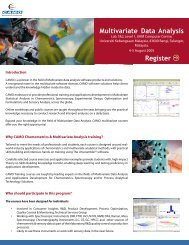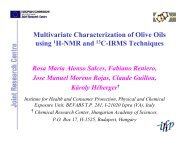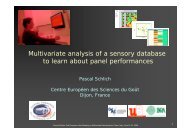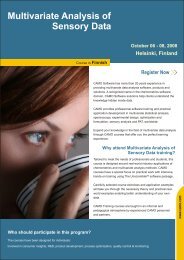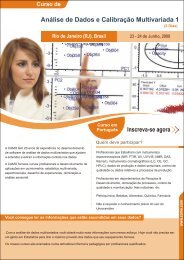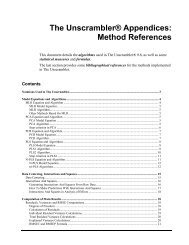A Handy Tool for Doing Chemometrics - The ... - CAMO Software
A Handy Tool for Doing Chemometrics - The ... - CAMO Software
A Handy Tool for Doing Chemometrics - The ... - CAMO Software
Create successful ePaper yourself
Turn your PDF publications into a flip-book with our unique Google optimized e-Paper software.
<strong>The</strong> Unscrambler ®<br />
A <strong>Handy</strong> <strong>Tool</strong> <strong>for</strong> <strong>Doing</strong> <strong>Chemometrics</strong><br />
Prof. Waltraud Kessler<br />
Prof. Dr. Rudolf Kessler<br />
Hochschule Reutlingen, School of Applied Chemistry<br />
Steinbeistransferzentrum Prozesskontrolle und Datenanalyse<br />
Camo Process AS
Topics<br />
• <strong>The</strong> Unscrambler ® by Camo<br />
• Many possibilities <strong>for</strong> Analysing Data<br />
• Examples<br />
• NIR-Spectra<br />
• Fluorescence Exitation Emission Spectra<br />
• Life Demonstration<br />
• 3-way Data Handling<br />
2
<strong>The</strong> Unscrambler ®<br />
Main Features<br />
Exploratory Analysis<br />
Descriptive statistics<br />
Principal Component Analysis (PCA)<br />
Multivariate Regression Analysis<br />
Partial Least Squares regression (PLS)<br />
Principal Component Regression (PCR)<br />
Multiple Linear Regression (MLR)<br />
Prediction<br />
Classification<br />
Soft Independent Modeling of Class Analogies (SIMCA)<br />
PLS-Discriminant Analysis<br />
Experimental Design<br />
Fractional and full factorial designs, Placket-Burmann,<br />
Box Behnken, Central Composite, Classical mixture<br />
designs, D-optimal designs<br />
ANOVA, Response Surface ANOVA, PLS-R<br />
3
<strong>The</strong> Unscrambler ®<br />
• Raw data checks<br />
• Data preprocessing<br />
• Over 100 pre-defined plots<br />
• Automatic outlier detection<br />
• Automatic variable selection<br />
• … and more<br />
Also Features…<br />
4
Example: Fiber Board Production<br />
In-situ Measurements of Fibres in Blowpipe<br />
NIR FOSS Process<br />
Spectrometer<br />
with fibre bundle and<br />
diffuse reflectance probe<br />
400 - 2200 nm<br />
Blowpipe:<br />
~ 180°C<br />
~ 5 bar<br />
~ velocity of fibres ~ 20 m/s<br />
5
Fiber Board Production<br />
NIR-Spectra of Fibres in Blowpipe<br />
Spectra contain the<br />
following in<strong>for</strong>mation:<br />
• kind of wood<br />
• fineness<br />
• degradation of lignin<br />
In<strong>for</strong>mation is hidden within complete wavelength range<br />
In<strong>for</strong>mation overlaps – separation by PCA<br />
6
PC2 = Fineness<br />
coarse fine<br />
Principal Component Analysis<br />
Separate the Overlapping In<strong>for</strong>mation<br />
mRf<br />
PC2 ScoresmRf<br />
mRf<br />
0.05<br />
0<br />
-0.05<br />
oRf oRf<br />
oRf oRf<br />
oRf oRf oRf oRf<br />
oRf oRf oRf<br />
oRf<br />
oRf<br />
oRf<br />
-0.10<br />
RESULT8, X-expl: 72%,24%<br />
-0.05 0 0.05 0.10<br />
oRf<br />
oRf<br />
oRf<br />
oRf<br />
oRf<br />
oRfoRf oRf oRf oRf<br />
oRf<br />
oRf<br />
oRg<br />
oRg<br />
oRg<br />
oRg oRg<br />
oRg<br />
oRg<br />
oRg<br />
oRg<br />
oRg oRg<br />
oRg<br />
oRg oRg<br />
oRg<br />
oRg<br />
oRg oRg oRg oRg<br />
oRgoRg oRg<br />
oRg oRg<br />
oRg<br />
oRg<br />
oRg oRg<br />
oRg oRg<br />
oRg<br />
mRf<br />
mRf<br />
mRf mRf mRfmRf<br />
mRf<br />
mRf<br />
mRf<br />
mRf<br />
mRf<br />
mRf<br />
mRf mRf<br />
mRf mRf mRf<br />
mRf mRf<br />
mRf mRf<br />
mRg<br />
mRf<br />
mRg mRg<br />
mRg<br />
mRg<br />
mRg<br />
mRg<br />
mRg<br />
mRg<br />
mRg<br />
mRg mRg<br />
mRg<br />
mRg<br />
mRg mRg mRg<br />
mRg<br />
mRg mRg mRg mRg<br />
mRg<br />
mRg mRg mRg<br />
mRg mRg<br />
mRg<br />
mRg mRg mRg<br />
mRg mRg<br />
mRg mRg<br />
PC1<br />
mRf<br />
mRf<br />
mRf<br />
mRf<br />
mRf<br />
PC1 = kind of wood: Spruce Spruce with bark<br />
mRf<br />
7
0.1<br />
0<br />
-0.1<br />
500<br />
RESULT9, PC(X-expl): 1(72%)<br />
1000 1500 2000<br />
Spruce<br />
with bark<br />
Spruce<br />
Principal Component Analysis<br />
Scores and Loadings <strong>for</strong> PC1 and PC2<br />
X-loadings<br />
PC1:Kind of wood<br />
0.05<br />
0<br />
-0.05<br />
-0.10<br />
Scores<br />
06:21:49_13.11. 11:43:52_13.11. 07:05:02_14.11. 14:15:56_14.11.<br />
RESULT2, PC(X-expl): 1(95%)<br />
X-variables<br />
Samples<br />
0.1<br />
0<br />
-0.1<br />
X-loadings<br />
500<br />
RESULT9, PC(X-expl): 2(24%)<br />
1000 1500 2000<br />
0.05<br />
0<br />
-0.05<br />
PC2:Fineness<br />
Scores<br />
06:21:49_13.11. 10:19:54_13.11. 14:37:28_13.11. 08:47:24_14.11. 14:06:48_14.11.<br />
RESULT5, PC(X-expl): 2(24%)<br />
Samples<br />
fine<br />
X-variables<br />
coarse<br />
8
0.02<br />
0.01<br />
0<br />
-0.01<br />
-0.02<br />
PLS Regression<br />
Degradation of Lignin <strong>for</strong> Spruce<br />
2.2<br />
2.2 2.2<br />
2.2<br />
2.5<br />
2.5 2.5<br />
2.5<br />
2.5 2.5<br />
2.5 2.5 2.5 2.5<br />
2.5<br />
2.5<br />
2.5<br />
-0.06 -0.03 0 0.03 0.06<br />
RESULT16, X-expl: 80%,5% Y-expl: 88%,6%<br />
0.0000020<br />
0.0000015<br />
0.0000010<br />
0.5E-06<br />
0<br />
RESULT16, PC: 2 2<br />
PC2 Scores<br />
X-variance Residual Sample Variance<br />
2.9 2.9<br />
2.9 2.9<br />
2.9<br />
2.9<br />
2.9 2.9 2.9<br />
2.9 2.9<br />
2.9<br />
2.9<br />
PC1<br />
Samples<br />
10 20 30<br />
3.0<br />
2.7<br />
2.4<br />
21<br />
Predicted Y<br />
Elements:<br />
Slope:<br />
Offset:<br />
Correlation:<br />
RMSEP:<br />
SEP:<br />
Bias:<br />
30<br />
0.910025<br />
0.237915<br />
0.941680<br />
0.085069<br />
0.086517<br />
0.000981<br />
2.1 2.4 2.7 3.0<br />
RESULT16, (Y-var, PC): (SFC,2)<br />
0.04<br />
0.03<br />
0.02<br />
0.01<br />
0<br />
RESULT16, PC: 2 2<br />
Y-variance Residual Sample Variance<br />
Measured Y<br />
Samples<br />
10 20 30<br />
9
Mode Mode 33<br />
Mode 1<br />
I<br />
L<br />
Mode 2<br />
Analysing Three-Way Data<br />
K<br />
Sample mode -usually first mode<br />
Variable mode -usually second and/or third mode<br />
Two different types of modes<br />
are distinguished:<br />
• Sample mode - O<br />
• Variable mode - V<br />
OV 2 or O 2 V<br />
10
Substructures in Three-way Arrays<br />
K vertical slices<br />
L frontal slices I horizontal slices<br />
Three-way arrays can be divided into different slices<br />
Decide which slices are put together to <strong>for</strong>m a two-dimensional array<br />
11
Three-way Data Example:<br />
Fluorescence Excitation Emission Spectra<br />
• Samples: 32 fibres from steam treated and ground woodchips<br />
• X-Data: Fluorescence Excitation-Emission spectra<br />
(250 - 575 nm) x (300 - 600 nm)<br />
• Y-Data: Kind of wood (beech and spruce)<br />
Severity of treatment (a combination of time and temperature)<br />
Age of wood (fresh and old)<br />
Plate gap of grinding ( fine and coarse).<br />
12
Three-way Data Example:<br />
Fluorescence Excitation Emission Spectra<br />
Beech<br />
Spruce<br />
Treatment: low middle severe<br />
13
Fluorescence Excitation Emission Spectra<br />
Results of N-PLSR<br />
14
Fluorescence Excitation Emission Spectra<br />
x1 and x2 Loading Weights<br />
15
Possibilities <strong>for</strong> Three-way Data in<br />
<strong>The</strong> Unscrambler ®<br />
• 3D Data Import: ASCII, Excel, JCAMP-DX, Matlab<br />
• Swapping: toggle freely between the 6 OV 2 and 6 O 2 V<br />
layouts of a 3D table<br />
• Matrix plots: Contour and landscape plots of the samples<br />
• Variable sets: Create Primary variable sets and<br />
Secondary Variables sets<br />
16
<strong>The</strong> Unscrambler ® Benefits<br />
• Easy to make models<br />
• Easy to interpret results<br />
• High user-friendliness<br />
• Less time spent doing data analysis,<br />
more in<strong>for</strong>mation extracted from your data<br />
• Faster decision making<br />
17
Try <strong>The</strong> Unscrambler ® 9.2 <strong>for</strong> 30 days<br />
Free trial version available on www.camo.com<br />
� Fully functioning version<br />
� Includes the Unscrambler user manual<br />
� Includes 7 tutorial exercises and associated files<br />
� Includes 3 demonstration tours<br />
For details, contact:<br />
<strong>CAMO</strong> <strong>Software</strong> India Pvt. Ltd.,<br />
14 -15, Krishna Reddy Colony, Domlur Layout,<br />
Bangalore - 560071, INDIA<br />
CamoAsia@Camo.com<br />
18



